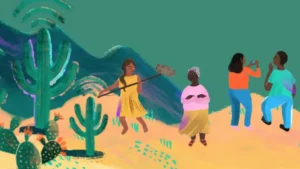By Haydeé Quijano by SocialTIC
Ideas that blew my mind and clicked during the Restoring Information Ecosystems in Latin America gathering
In November 2024, in the middle of Chilean spring time, in the context of the research project “Working for healthier information ecosystems: Collective visions from civil society in Latin America and the Caribbean”, we, women from Latin America and the Caribbean, got together to share experiences and ideas on how to restore information ecosystems in Latin American contexts.
We spent three days exploring perspectives from different points of view and sites of knowledge: women communicators, journalists, media activists, collectives and civil society organizations in the region. In addition to talking, we also drew, made memes, maps of possibilities, embroidered and turned on the radio.
It often happens to me that, in collective dialogue spaces, unexpected connections of ideas arise, “caídas de 20” (as we call it in Mexico). Ideas that connect, questions to which you find answers, new paths of thoughts and possibilities. These are the moments when we find inspiration, creativity and imagination.
With this inventory of ideas and knowledge, I want to collect those “seeds” that we can sow in future collaborations and intentions to restore resilient information ecosystems.
The notes in the notebook are actually ideas and contributions that emerged in the conversations we had, in the shared learning, in our fanzines, in the radio we turned on in the dark and in the threads we embroidered.
- “We are not islands”
This phrase, seen in a fanzine, makes me think about our radical, or deep, interdependence and interconnectedness. Recognizing ourselves in this way, as part of an ecosystem, where we communicate and complement each other to strengthen ourselves. “We are not islands” inspires us to form those collaborative networks or bridges that allow us to create other realities and modes of resistance to improve our environment.
- “There’s a bug inside me”
This phrase sparked a conversation about apocalyptic thoughts and how the end of the world will be analog. We shared about how we feel after consuming content on social networks and how we sometimes end up feeling exhaustion and hopelessness.
We asked ourselves about who has the power to manipulate or push those narratives, imaginaries and feelings on and off the internet. About how it is no coincidence that the contents that arouse fear, anger or helplessness are the ones privileged by the algorithms.
After all, we agreed that we can break the cycle, and that this “bug” can be transformed into strength and resistance, to take control and move from apocalypse to hope.
In infoactivism, we constantly reflect on how to transform information into action and these ideas broadened our views on how to transform hope into action.
- “Be able to disoñar”
Disoñar is to design with dreams. It’s to dream of a different world. It’s not just about preserving the dream; it’s also about building it, as León Octavio, environmental activist, artist, musician, and founder of the ecovillage Villa Maga, tells us.
This idea of believing in and sustaining utopias, imagining and actively working on profound changes that bear fruit for the futures we want, resonates with Kriza Gomez’s perspective. “Foresight is about systematically imagining several probable futures, identifying which future we prefer, and starting today to make it happen.”
An alternative to always reacting to negativity and constantly being against things, is to project change and to design new dynamics with values that sustain it. For example: avoid “making a case” (and avoid amplifying) the anti-rights and haters in social networks. These ideas were also transformed into fanzines such as the “recipe book to confront power jiji”, exercises: such as the map of possibilities and slogans, such as “against the click tyranny.”
- “Communities pollinate us, and vice versa”
As we are inspired by the resilience of nature, I find the metaphor of pollination interesting. In this sense, I interpret “pollination” in two ways:
1) A dynamic exchange of ideas, talents and experiences of people and communities to nurture us and make us collectively more resilient to challenges related to information, internet and digital technologies.
2) Recognizing our roles in complex information systems, where we are part of something bigger. This perspective allows us to recognize the interplay between individuality and collective togetherness.
- “Find poetry, even in methodology”
In this meeting I was inspired by the different methodologies we shared to transmit knowledge and generate meaningful conversations. The flexibility and confidence to design our own agenda allowed us to go beyond intellectual or rational intention and find other creative practices such as embroidery, drawing, writing.
We embroidered, made zines, wrote fictional stories, while sharing not only ideas, but also emotions. These activities as means of expression and creation facilitate connecting with beauty, tranquility, well-being and trust. In this case, they allowed for deeper connections.
In 2025, The Engine Room team will launch a website with learnings and results from this encounter, where we will be able to find more information and inspiration to continue restoring our information ecosystems.
Thanks to The Engine Room team, to the powerful group that was formed and to all the people who made this encounter possible.

